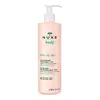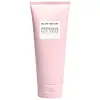What's inside
What's inside
 Key Ingredients
Key Ingredients

 Benefits
Benefits

 Concerns
Concerns

 Ingredients Side-by-side
Ingredients Side-by-side

Water
Skin ConditioningGlycerin
HumectantCoco-Caprylate/Caprate
EmollientCocos Nucifera Oil
MaskingHelianthus Annuus Seed Oil
EmollientBehenyl Alcohol
EmollientPentylene Glycol
Skin ConditioningArachidyl Alcohol
EmollientParfum
MaskingTocopherol
AntioxidantSaccharide Isomerate
HumectantCarbomer
Emulsion StabilisingSodium Stearoyl Glutamate
CleansingArachidyl Glucoside
EmulsifyingCaprylyl Glycol
EmollientGlyceryl Caprylate
EmollientSodium Gluconate
Skin ConditioningSodium Hydroxide
BufferingCamellia Sinensis Flower Extract
PerfumingCitric Acid
BufferingSodium Citrate
BufferingLimonene
PerfumingCitral
PerfumingLinalool
PerfumingAlpha-Isomethyl Ionone
PerfumingGeraniol
PerfumingWater, Glycerin, Coco-Caprylate/Caprate, Cocos Nucifera Oil, Helianthus Annuus Seed Oil, Behenyl Alcohol, Pentylene Glycol, Arachidyl Alcohol, Parfum, Tocopherol, Saccharide Isomerate, Carbomer, Sodium Stearoyl Glutamate, Arachidyl Glucoside, Caprylyl Glycol, Glyceryl Caprylate, Sodium Gluconate, Sodium Hydroxide, Camellia Sinensis Flower Extract, Citric Acid, Sodium Citrate, Limonene, Citral, Linalool, Alpha-Isomethyl Ionone, Geraniol
Water
Skin ConditioningC12-15 Alkyl Benzoate
AntimicrobialGlycerin
HumectantC13-15 Alkane
SolventHydrogenated Ethylhexyl Olivate
EmollientArachidyl Alcohol
EmollientCapryloyl Glycerin/Sebacic Acid Copolymer
Skin ConditioningDiheptyl Succinate
EmollientBehenyl Alcohol
EmollientCetyl Alcohol
EmollientCitrullus Lanatus Fruit Extract
Skin ConditioningMangifera Indica Seed Butter
Skin ConditioningCitrullus Lanatus Seed Oil
EmollientSodium Hyaluronate
HumectantHibiscus Sabdariffa Flower Extract
Skin ConditioningSodium Hyaluronate Crosspolymer
HumectantHyaluronic Acid
HumectantHydrolyzed Hyaluronic Acid
HumectantPlatonia Insignis Seed Butter
EmollientHydrolyzed Glycosaminoglycans
HumectantHydrolyzed Gardenia Florida Extract
AntioxidantCoffea Arabica Fruit Extract
AntioxidantEquisetum Arvense Extract
AstringentHelianthus Annuus Seed Oil
EmollientArachidyl Glucoside
EmulsifyingTocopherol
AntioxidantPentylene Glycol
Skin ConditioningPolyacrylate Crosspolymer-6
Emulsion StabilisingPropanediol
SolventHydroxyethyl Acrylate/Sodium Acryloyldimethyl Taurate Copolymer
Emulsion StabilisingHydrogenated Olive Oil Unsaponifiables
EmollientCaprylyl Glycol
EmollientChlorphenesin
AntimicrobialEthylhexylglycerin
Skin ConditioningTrisodium Ethylenediamine Disuccinate
Myristyl Alcohol
EmollientStearyl Alcohol
EmollientLauryl Alcohol
EmollientSodium Hydroxide
BufferingBenzyl Glycol
SolventMaltodextrin
AbsorbentRaspberry Ketone
MaskingPhenoxyethanol
PreservativeLimonene
PerfumingHexyl Cinnamal
PerfumingParfum
MaskingWater, C12-15 Alkyl Benzoate, Glycerin, C13-15 Alkane, Hydrogenated Ethylhexyl Olivate, Arachidyl Alcohol, Capryloyl Glycerin/Sebacic Acid Copolymer, Diheptyl Succinate, Behenyl Alcohol, Cetyl Alcohol, Citrullus Lanatus Fruit Extract, Mangifera Indica Seed Butter, Citrullus Lanatus Seed Oil, Sodium Hyaluronate, Hibiscus Sabdariffa Flower Extract, Sodium Hyaluronate Crosspolymer, Hyaluronic Acid, Hydrolyzed Hyaluronic Acid, Platonia Insignis Seed Butter, Hydrolyzed Glycosaminoglycans, Hydrolyzed Gardenia Florida Extract, Coffea Arabica Fruit Extract, Equisetum Arvense Extract, Helianthus Annuus Seed Oil, Arachidyl Glucoside, Tocopherol, Pentylene Glycol, Polyacrylate Crosspolymer-6, Propanediol, Hydroxyethyl Acrylate/Sodium Acryloyldimethyl Taurate Copolymer, Hydrogenated Olive Oil Unsaponifiables, Caprylyl Glycol, Chlorphenesin, Ethylhexylglycerin, Trisodium Ethylenediamine Disuccinate, Myristyl Alcohol, Stearyl Alcohol, Lauryl Alcohol, Sodium Hydroxide, Benzyl Glycol, Maltodextrin, Raspberry Ketone, Phenoxyethanol, Limonene, Hexyl Cinnamal, Parfum
 Reviews
Reviews

Ingredients Explained
These ingredients are found in both products.
Ingredients higher up in an ingredient list are typically present in a larger amount.
Arachidyl Alcohol is a fatty alcohol made from peanut oil. It is an emollient, emulsifier, and thickener.
You'll most likely find this ingredient as an emulsifier in water-based cosmetics.
We don't have a description for Arachidyl Glucoside yet.
Behenyl Alcohol is a type of fatty alcohol (these are different from the drying, solvent alcohols).
Fatty Alcohols have hydrating properties and are most often used as an emollient or to thicken a product. They are usually derived from natural fats and oils; behenyl alcohol is derived from the fats of vegetable oils.
Emollients help keep your skin soft and hydrated by creating a film that traps moisture in.
In 2000, Behenyl Alcohol was approved by the US as medicine to reduce the duration of cold sores.
Learn more about Behenyl AlcoholCaprylyl Glycol is a humectant and emollient, meaning it attracts and preserves moisture.
It is a common ingredient in many products, especially those designed to hydrate skin. The primary benefits are retaining moisture, skin softening, and promoting a healthy skin barrier.
Though Caprylyl Glycol is an alcohol derived from fatty acids, it is not the kind that can dry out skin.
This ingredient is also used as a preservative to extend the life of products. It has slight antimicrobial properties.
Learn more about Caprylyl GlycolGlycerin is already naturally found in your skin. It helps moisturize and protect your skin.
A study from 2016 found glycerin to be more effective as a humectant than AHAs and hyaluronic acid.
As a humectant, it helps the skin stay hydrated by pulling moisture to your skin. The low molecular weight of glycerin allows it to pull moisture into the deeper layers of your skin.
Hydrated skin improves your skin barrier; Your skin barrier helps protect against irritants and bacteria.
Glycerin has also been found to have antimicrobial and antiviral properties. Due to these properties, glycerin is often used in wound and burn treatments.
In cosmetics, glycerin is usually derived from plants such as soybean or palm. However, it can also be sourced from animals, such as tallow or animal fat.
This ingredient is organic, colorless, odorless, and non-toxic.
Glycerin is the name for this ingredient in American English. British English uses Glycerol/Glycerine.
Learn more about GlycerinHelianthus Annuus Seed Oil is the oil derived from the seeds of a Sunflower. Sunflower seed oil is non-fragrant. It is an emollient, meaning it helps to soften the skin.
Sunflower seed oil contains many fatty acids. The fatty acids found in sunflower seeds include (from highest amount to least): linoleic acid, myristic acid, palmitic acid, stearic acid, arachidic acid, oleic acid, and linolenic acid.
These fatty acids help the skin create ceramides. Ceramides play a role in repairing the skin barrier.
Helianthus Annuus Seed Oil helps moisturize the skin. This in turn helps the skin look more rejuvenated and smoother.
Sunflowers are rich in vitamin E.
Historians believe Indigenous cultures of North America domesticated sunflowers before corn. Thus they relied on sunflower oil for a variety of uses. One such use is moisturizing skin and hair.
Sunflower seed oil may not be fungal acne safe. We recommend speaking with a professional if you have any concerns.
Learn more about Helianthus Annuus Seed OilLimonene is a fragrance that adds scent and taste to a formulation.
It's found in the peel oil of citrus fruits and other plants such as lavender and eucalyptus. The scent of limonene is generally described as "sweet citrus".
Limonene acts as an antioxidant, meaning it helps neutralize free radicals.
When exposed to air, oxidized limonene may sensitize the skin. Because of this, limonene is often avoided by people with sensitive skin.
The term 'fragrance' is not regulated in many countries. In many cases, it is up to the brand to define this term. For instance, many brands choose to label themselves as "fragrance-free" because they are not using synthetic fragrances. However, their products may still contain ingredients such as essential oils that are considered a fragrance.
Learn more about LimoneneParfum is a catch-all term for an ingredient or more that is used to give a scent to products.
Also called "fragrance", this ingredient can be a blend of hundreds of chemicals or plant oils. This means every product with "fragrance" or "parfum" in the ingredients list is a different mixture.
For instance, Habanolide is a proprietary trade name for a specific aroma chemical. When used as a fragrance ingredient in cosmetics, most aroma chemicals fall under the broad labeling category of “FRAGRANCE” or “PARFUM” according to EU and US regulations.
The term 'parfum' or 'fragrance' is not regulated in many countries. In many cases, it is up to the brand to define this term.
For instance, many brands choose to label themselves as "fragrance-free" because they are not using synthetic fragrances. However, their products may still contain ingredients such as essential oils that are considered a fragrance by INCI standards.
One example is Calendula flower extract. Calendula is an essential oil that still imparts a scent or 'fragrance'.
Depending on the blend, the ingredients in the mixture can cause allergies and sensitivities on the skin. Some ingredients that are known EU allergens include linalool and citronellol.
Parfum can also be used to mask or cover an unpleasant scent.
The bottom line is: not all fragrances/parfum/ingredients are created equally. If you are worried about fragrances, we recommend taking a closer look at an ingredient. And of course, we always recommend speaking with a professional.
Learn more about ParfumPentylene glycol is typically used within a product to thicken it. It also adds a smooth, soft, and moisturizing feel to the product. It is naturally found in plants such as sugar beets.
The hydrophilic trait of Pentylene Glycol makes it a humectant. As a humectant, Pentylene Glycol helps draw moisture from the air to your skin. This can help keep your skin hydrated.
This property also makes Pentylene Glycol a great texture enhancer. It can also help thicken or stabilize a product.
Pentylene Glycol also acts as a mild preservative and helps to keep a product microbe-free.
Some people may experience mild eye and skin irritation from Pentylene Glycol. We always recommend speaking with a professional about using this ingredient in your routine.
Pentylene Glycol has a low molecular weight and is part of the 1,2-glycol family.
Learn more about Pentylene GlycolSodium Hydroxide is also known as lye or caustic soda. It is used to adjust the pH of products; many ingredients require a specific pH to be effective.
In small amounts, sodium hydroxide is considered safe to use. However, large amounts may cause chemical burns due to its high alkaline.
Your skin has a natural pH and acid mantle. This acid mantle helps prevent harmful bacteria from breaking through. The acid mantle also helps keep your skin hydrated.
"Alkaline" refers to a high pH level. A low pH level would be considered acidic.
Learn more about Sodium HydroxideTocopherol (also known as Vitamin E) is a common antioxidant used to help protect the skin from free-radicals and strengthen the skin barrier. It's also fat soluble - this means our skin is great at absorbing it.
Vitamin E also helps keep your natural skin lipids healthy. Your lipid skin barrier naturally consists of lipids, ceramides, and fatty acids. Vitamin E offers extra protection for your skin’s lipid barrier, keeping your skin healthy and nourished.
Another benefit is a bit of UV protection. Vitamin E helps reduce the damage caused by UVB rays. (It should not replace your sunscreen). Combining it with Vitamin C can decrease sunburned cells and hyperpigmentation after UV exposure.
You might have noticed Vitamin E + C often paired together. This is because it is great at stabilizing Vitamin C. Using the two together helps increase the effectiveness of both ingredients.
There are often claims that Vitamin E can reduce/prevent scarring, but these claims haven't been confirmed by scientific research.
Learn more about TocopherolWater. It's the most common cosmetic ingredient of all. You'll usually see it at the top of ingredient lists, meaning that it makes up the largest part of the product.
So why is it so popular? Water most often acts as a solvent - this means that it helps dissolve other ingredients into the formulation.
You'll also recognize water as that liquid we all need to stay alive. If you see this, drink a glass of water. Stay hydrated!
Learn more about Water